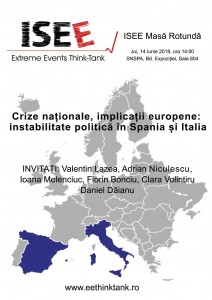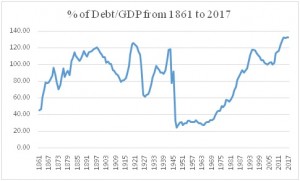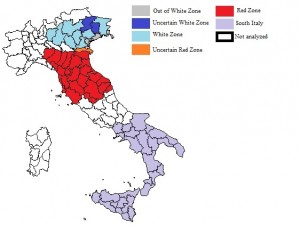Institutul pentru Studierea Evenimentelor Extreme (ISEE), din cadrul SNSPA a organizat o masă rotundă joi, 14 iunie, ora 14:00, în sala 804. Tema abordată cu această ocazie a fost legătura dintre crizele politice din statele membre și Uniunea Europeană, sub titlul „Crize naționale, implicații europene: instabilitate politică în Spania și Italia”.
Au participat acad. prof. univ. dr. Daniel Dăianu (BNR/SNSPA), prof. univ. dr. Cristian Păun (ASE), prof. univ. dr. Florin Bonciu (RAU), Lect. univ. dr. Ioana Melenciuc (MAE/SNSPA), conf. univ. dr. Clara Volintiru (ASE), prof. univ. dr. Adrian Niculescu (SNSPA), prof. univ. dr. Paul Dobrescu (SNSPA), prof. univ. dr. Florina Pînzaru (SNSPA), prof. univ. dr. Vittorio Amato (Universitatea din Napoli „Federico II”), prof. univ. dr. Gianluca Luise (Universitatea din Napoli „Federico II”) și alții. O sinteză a discuțiilor va fi disponbilă pe site-ul ISEE în scurt timp.
Italy between structural and current crisis: an overview of the present status.
Matteo ZANELLATO[1]
10/07/2018
Italy is facing a crisis that seems interminable, or it rather faces several crises: political, economic, financial and social. What are the reasons that brought Italy, one of the EU founding countries, in the current situation? I try to analyse the causes, distinguishing between “structural” and “current” difficulties.
Among the structural difficulties, the main problem is that of the public debt, which is a problem as old as the Italian state. To complete the unification of the peninsula – in the second half of XIX century – the Kingdom of Sardinia incurred expenses that complicated its future state building process.In 1870, the debt to GDP ratio reached 96% and increased even more around 1890, or just after the agrarian crisis, reaching 120% in 1897. Despite the decline before the 1st World War, in 1920 it reached again 125%. After the 2ndWorld War the problem was solved because by the 70s, the public debt was just 37%, but this did not last for long. The center left and the pentapartito governments in the eighties brought the ratio over 100%, with an additional increase caused by the burst of Tangentopoli[2]. Then the ratio decreased progressively up to 99.7% in 2007, before the economic crisis. Thenit increasedagain, bringing to power the technocratic governments of Monti and Letta. Currently, the public debt has reached the 132% threshold. Italy is therefore economically exposed to any external shock due to the size of its public debt[3].
Source: the author[4]
Another structural difficulty is the gap between the North and the South. Several scholars addressed the topic, offering different perspectives. As I am not an economist, I want to focus on political motivations or more precisely on the impact of the Italian political subcultures[5]. In his book La QualitàdellaDemocrazia in Italia. Capitalesociale e Politica (2011) Almagisti argues how different subcultures have affected the different outputs of the Italian regions, through the formation or not of social capital, exactly as Robert Putnam did in Making Democracy Work (1993). In Sviluppo economico e trasformazioni socio-politiche dei sistemi territoriali a economia diffusa. Le subculture politicheterritoriali(1981), Carlo Triglia explains that political subcultures indicate not only a preference for a political culture (and therefore for a party), but rather indicate an entire local political system, legitimized by a dense institutional network. The strong fracture centre/periphery in Italy favoured the strengthening of the two subcultures: the white one and the red one. The third area, which does not really correspond to a political subculture, is southern Italy.
To explain the differences between the North and the South (without completely retracing the history of Italy)I refer to the agrarian crisis of 1880. The white area responds to the former territory of the RepubblicaSerenissima’sStato de Tera area, meaning the current Veneto (without Rovigo), the current Friuli (without the provinces of Trieste and Gorizia), the Province of Trento and the Lombard’ provinces of Bergamo and Brescia[6]. The society was characterized by the land-owning family, meaning families that worked the land to insure their needs, and that trusted the established order. But due to the old Venetian law, a tendency towards polycentrism and localism was accentuated. The church was the only institution to produce social capital and it was The Catholic Church, through the Rerum Novarum[7] and the activism of the its association network that solved the agrarian crisis in this region.
The red zone responds to the province of Rovigo and to those regions which in the Middle Ages enjoyed the experience of principalities and republics. The political freedom granted by the republics allowed the affirmation of the freedom of conversion, which was also defended against the church. Social capital was produced by networks of trust and solidarity, which during the agrarian crisis was best interpreted by socialist movements – that proposed laic and reform programs.
What about the South? During the state building process, the debt of the Kingdom of Italy prevented the creation of a bureaucracy and a strategy of integration of the southern regions, leaving the agriculture involute and unproductive not only compared the foreign countries, but also compared to northern Italy. During the agrarian crisis the south found no solution except in the amoral familyism[8], or in the total distrust in institutions culminating with the birth of the brigand culture[9].
In the period of the First Republic, the two subcultures were represented and strengthened by the Democrazia Cristiana (DC) in the white area, and by the Italian Communist Party (PCI) in the red area. In the south, the political party that succeeded in obtaining the majority of votes was the DC, which however adopted different behaviours and practices than the white zone (Allum 1997, 219).
Source: the author
Italy has another structural problem: it has always been a politically unstable country. Almond and Verba showed in The Civic Culture: Political Attitudes and Democracy in Five Nations (1963) that Italy lacked a civic culture at national level, but it was replaced by political subcultures and democratic anchorage by the political parties. In this context, the 50 governments that followed one another from 1946 to 1994 demonstrated the Italian political instability at the government level, but not at the political level, given that the Italian party system did not change for the duration of the so-called first republic. The first signs of a representation’ crisis occurred with the referendum on divorce, when it was understood that DC (which was against) and the PCI (which was in favour but it did a subdued campaign because they believed that Italians were lined up with the Church) did not understand the radical change of Italian society. In the so-called second republic through the “Mattarellum” electoral law, it seemed that the right harmony between representation and governability had been found. The majority guaranteed governability, while the proportional system guaranteed representation. The political subcultures changed the reference party even if, after the Tangentopoli crack, social capital moved towards civic associations, moving away from politics in the strict sense. In the north, the white subculture stopped supporting the DC in favour of the Lega Nord (LN), in the red area the red subculture embraced the centre left led by Occhetto, D’Alema and Prodi. In the south, Forza Italia (FI) replaced DC.
The growing separation of parties from society is also generated by wrong choices made by parties themselves. To give some examples, in the last ten years the government parties have reformed the electoral law with the aim of favouring the loss of the opponent (Feltri, 2017) and to strengthen the party secretariats towards the territory.
The current difficulties need to be added to these structural difficulties. The tax burden that goes to 48.8% (source Adkronos) but that in some cases reaches 70%[10], as Befera, director of the Tax Agency states. The bureaucracy delays both the process of digitization and the payment of the commissions, and the European Commission deferred it.
Among the current difficulties we need to speak about the last elections. Today, political geography seems to have changed. Italy no longer represents the two subcultures and the third area identified above, but is cut in two. If we look at the result of the last elections, we see that in the north the votes go to the LN that proposed the Flat Tax, or a single rate regardless of income[11], and in the south the votes go to the Movimento 5 Stelle (M5S) that proposed an income of citizenship for those who do not find work.
This net division of Italy, together with the electoral law and a political climate characterized by a high level of conflict between the political forces in which anti-system parties have been able to grow, has led to a political crisis that risked seeing the first parliament of Italian history unable to produce a government. The crisis lasted 89 days: the electoral law made by the Democratic Party prevented the victory of a party or a coalition, but, because of the unexpected growth of the LN in the centre right (which has passed FI) and the M5S that has exceeded 30% and at the same time the PartitoDemocratico (PD)’s defeat under 25%, the so-called mainstream parties were attained from creating a grosseKoalition government.
The President of the Republic has tried the two possible ways: alliance between centre-right and M5S, and between centre left and M5S but when he did not meet the support of the parties, he proposed a “neutral” government for the summer and to return to the vote in the autumn. Just when it seemed that the parties were not able to agree with each other, Lega and M5S managed to approach their positions (but the Lega had to give up the alliance of centre-right with FI, that went to the opposition). The controversy with President Mattarella on the figure of Prof. Paolo Savona, which was proposed by Salvini and Di Maio as Minister of Finance was resolved by moving him to the ministry of European affairs.
Even if the government was formed, the difficulties lie in satisfying two completely different types of electorate and in the capacities of the leaders of the two political parties to respect the (high) expectations of the electorate. Personally, I believe that Prof. Paolo Savona can represent a positive factor for the European Union (it can stimulate the debate within the EU). Although he is contrary to the governance of the Euro, he has always declared to be in favour of the Union and a critical but competent voice can spur the impasse that crosses the EU for several years. I also believe that the republican institutions will be able to institutionalize the two populist parties that govern today. My trust is based on the past, whenthese institutions were able to manage stresses as the transition from fascism to democracy, the reintegration into the political life of many former fascists, the red and black terrorism of the 60s and 70s and the fall of the Berlin Wall. But even more recently, they were able to face the fall of traditional parties, the normalization of the post-fascist MovimentoSocialeItaliano and the entry of Berlusconi into politics.
[1]Matteo ZANELLATO is PhD Candidate at National University of Political Studies and Public Administration (SNSPA), Bucharest, Romania and alumnus of University of Padua, Italy. His research interests are Party Politics and Philosophy of Technology. e-mail: zanellatomatteo88@gmail.com
[2]Tangentopoli:The term refers to an imaginary city where corruption is a common habits.To this term was associated the work of the pool of Milan, defined precisely, pool Clean Hands in the years 1992-1994 that began to investigate corruption in Milan and between the dishonest relations between politics and entrepreneurship. The exchange of accusations between the suspects led to further investigations, arrests and even suicides of political figures, such as the socialist Sergio Moroni. The investigations led indirectly to the dissolution of the Italian traditional political parties, the PSI and the DC.
[3] The Istituto Bruno Leoni counter of public debt count 2.329.906.940 € at 12 a.m. of 22/06/2018, but this data is constantly growing. http://www.brunoleoni.it/il-debito-pubblico-sul-tuo-sito
[4]Source: Matteo Zanellato’selaboration on Banca d’Italia, Istat and Ragioneria Generale dello Stato data. The data from 1861 to 1971 are taken from the Ministry of the Treasury, in Camodeca, Canziani 2006.I deficit di bilancio dello Stato Italiano nella Ragioneria e nelle Finanze Pubbliche. The data from 1972 to 1988 are taken from Forte (1999) in Camodeca, Canziani 2006.I deficit di bilancio dello Stato Italiano nella Ragioneria e nelle Finanze Pubbliche. The data from 1989 to 2017 are taken by ISTAT, Banca d’Italia and the major newspaper as Corrieredella Sera, Il Sole 24 Ore and Repubblica.
[5] These reflections derive from the reading ofLa QualitàdellaDemocrazia in Italia. Capitalesociale e Politica (2011).
[6] Some authors as Almagisti (2011) define this area as the Veneto lungo.
[7] The encyclical that established the Church’s social doctrine
[8]By Amoral familyism, I mean the distrust on public institutions and a connection with a narrow circle of person, not necessary legal.
[9]Briganti were the ancestors of the mafia.
[10] https://www.105.net/news/tutto-news/245103/tasse-in-italia-la-pressione-fiscale-e-la-piu-alta-al-mondo.html
[11]This proposalsmay be against the constitution, because it collides with Article 53 from the Constitution of the Italian Republic – which states that “the tributary system is based on progressive criteria”.





